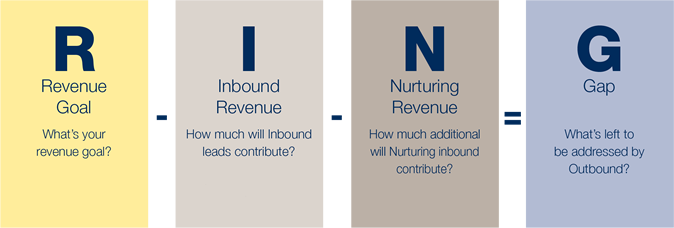What’s a good lead rate? How much should a lead cost?
These are questions stirring in the minds of executives everywhere. (Just google them.) The problem is they’re not so easy to answer; few have found success; and for that matter, are they even the right questions?
I have been in this business since 1991 and things have not changed dramatically over the past almost twenty-five years. (The lead rate for high quality, enterprise opportunity leads has been roughly flat.) That said, for several years the elephant in the room has been inbound marketing and inbound marketing lead rates. Many of today’s inbound pundits suffer from an over-reliance on inbound marketing (what I like to call “inbounditis”). They would have you believe that outbound marketing is equal to interruption marketing and is not productive. I beg to differ.
Read what Mike Weinberg, author of New Sales Simplified, says about this pervasive thought:
Many in what’s called the Sales 2.0 movement harshly declare that proactive targeting and prospecting for new business is dead. These so-called experts proclaim that cold-calling is ineffective and pursuing prospects that aren’t coming to you is a waste of time. These false pronouncements are having a severe negative impact on sales performance.
I have seen inbound lead rates reported as high as 11 – 14%. However, these so-called leads really are not leads. They include tire kickers, competitors, and students—even prisoners.
So, maybe we’re asking the wrong questions.
Mike Damphousse, founder, CEO and CMO of Green Leads and author of Smashmouth B2B Blog: Sales & Marketing Demand Gen places the focus on value: 1) The value of the inbound versus outbound lead; and 2) how far those leads are in the pipeline against the amount invested.
Here’s an excerpt from one of his recent blogs (May 2015):
This past week I was reading HubSpot’s study on the state of inbound marketing, and understandably, with HubSpot being in the inbound marketing business, the study showed that the marketing spend on inbound marketing is rising. It also determines that the price of an inbound generated lead is 3x less than the price of an outbound generated lead, $84 versus $220. (Inbound: SEO, SEM, Blogs; Outbound: Telemarketing, Email, Events).
I accept that, and I truly believe there is a place for inbound marketing in all of our marketing budgets. I do, however, challenge the value of that inbound lead versus the value of the outbound lead, and that was not discussed. What is the equity value of those leads—the lead equity? In simple terms, how far along is each of those generated leads in the pipeline and what is the value of that lead against the amount you have invested in it so far? Even at 3x the cost, it’s not apples and oranges.
The question we should ask ourselves is how many $84 leads does it take to get to pipeline, an active sales opportunity, and how many $220 leads does it take to get to pipeline. In my own business, where we do about equal billing on inbound/outbound spending, we have found that the increased quality of the outbound leads justifies the expense. For argument’s sake, let’s just say it takes 10 inbound sales leads to get one pipeline opportunity, and 3 outbound leads to do the same. That’s $840 for inbound, $660 for outbound. We attribute it to the fact that the outbound work does much of the screening and vetting and sometimes even the first steps of selling, thereby increasing the quality of the lead.
Absolutely right, Mike! Focusing on the number of leads and cost per lead misses the point. Focusing on the cost per pipelined deal and/or cost per closed deal IS the point. A very fine line makes the difference.
Let’s take a look at the average first-pass lead rates PointClear has experienced across multiple clients over the course of the last five years:
| 2011 | 2012 | 2013 | 2014 | 2015 (YTD) |
| 4.4% | 4.5% | 4.6% | 4.1% | 4.1% |
These are the results of one round of outbound only. (Most companies stop here.) Not bad, but could be better. This leads me to the revenue Gap:

The Gap, which can be determined using my RING formula, is critical to revenue generation. In my whitepaper RING: Mind the Gap I explain how pipeline and nurture dispositions (or completed contacts) in addition to lead dispositions can significantly increase lead rates—by up to 3x. By nurturing and optimizing to fill the GAP, companies can triple their lead rates in any given year. Unfortunately, most companies ignore this number and thereby forfeit the opportunity to do so.
So, again, perhaps we’re asking the wrong questions.
Instead of: What’s a good lead rate?
Ask: How can I optimize my lead rate?
Answer: Use the RING formula to determine the optimal lead rate for your company—which is likely triple the rate you thought was “good.”
And instead of: How much should leads cost?
Ask: Are the leads I generate driving revenue?
Answer: Carefully assess return on each marketing investment AND avoid the mistake of putting too many eggs in the inbound basket.
Bottom line? You don’t have to buy my numbers. But consider reframing your questions, and see what happens.
This article originally was published on ViewPoint | The Truth About Lead Generation –a blog exploring issues related to B2B sales, marketing and lead generation.











